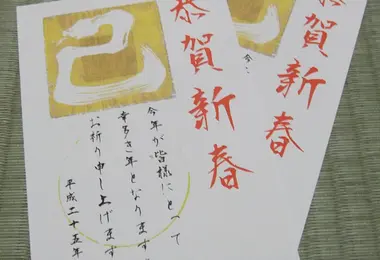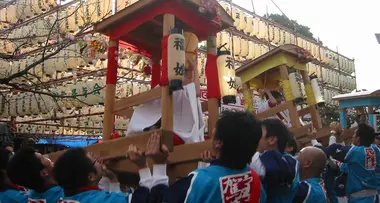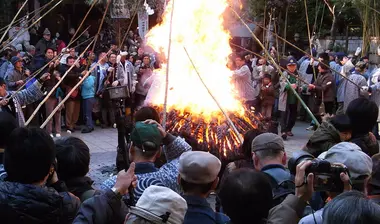Japan Festivals - January
- Published on : 18/11/2024
- by : Japan Experience
- Youtube
January marks the beginning of the new year in Japan, a time of tradition, festivities and spirituality. It's an excellent opportunity to discover the country's cultural richness through unique local events. Here are the main festivals not to be missed.
Shōgatsu: Japanese New Year
Dates: January 1 to 3
Location: All over Japan
New Year, or Shōgatsu, is Japan's most important holiday. During these days, families get together, exchange greeting cards and enjoy traditional dishes such as osechi ryōri (traditional Japanese New Year's meal, composed of symbolic dishes arranged in lacquered boxes) and mochi. Temples and shrines attract millions of visitors for hatsumōde, the first visit of the year, where people pray for health and happiness.
Dezomeshiki: Firemen's parade
Date: January 6th
Location: Tokyo and other major cities
This spectacular parade showcases the heroism of Japanese firefighters. The show includes acrobatic demonstrations on ladders, synchronized choreography and simulated interventions. A captivating event for fans of tradition and performance.
Tōka Ebisu: Prosperity Festival
January 9 to 11, Osaka
January 8 to 12, Kyoto
This festival celebrates Ebisu, the god of prosperity and business. Shrines like Nishinomiya Ebisu (near Osaka) welcome crowds who come to buy fukuzasa, decorated bamboo branches symbolizing good luck. The festive atmosphere is enlivened by food stalls and traditional dances.
Oni Hashiri: Ogres and flaming torches
Date: January 14th
Place: Gojo, (Nara prefecture)
The Dadado-no-Oni-Hashiri ritual at Nenbutsu temple is a festival of fire! Locals dress up as demons and run around the temple, creating a wild atmosphere. More specifically, the event features an ogre father, mother and child holding flaming torches, chasing away evil spirits to welcome spring. This tradition presents demons as symbols of fortune and happiness rather than evil.
Dontosai Festival
Date: January 14th
Location: Osaki Hachimangu Shrine, Miyagi
The Dontosai Festival is a traditional ritual marking the end of the New Year. Residents bring New Year decorations, such as shimenawa and daruma, to burn in a large sacred fire, a symbol of purification and renewal. The event is accompanied by prayers for health, prosperity and family security. Numerous participants, dressed in traditional garments or in light clothing despite the cold, add to the spiritual and festive atmosphere of this winter festival.
Santera Mairi: Three Temples Pilgrimage
Date: January 15th
Location: Hida Furukawa, Gifu Prefecture
This nocturnal pilgrimage through three Buddhist temples is illuminated by lanterns and candles. It offers a peaceful, mystical atmosphere, perfect for refocusing at the start of the year.
Nozawa Fire Festival
Date: January 15th
Place: Nozawa onsen
One of the three biggest fire festivals in Japan. This event, dedicated to the god Dosojin, includes a symbolic battle in which men aged 25 and 42 defend a temporary shrine against villagers armed with flaming torches. The festival, marked by prayers for health, fertility and a good harvest, also features fireworks, singing, drumming and rituals. The spectacular battle begins at 8.30pm and ends with the burning of the shrine, attracting large numbers of visitors every year.
Mukonage & Suminuri
Date: January 15th
Location: Matsunoyama Onsen (Niigata prefecture)
The Mukonage & Suminuri festival is a unique tradition. During the Mukonage, newlyweds are symbolically thrown from the floor of a shrine into the deep snow that covers the ground. to mark the beginning of their new lives. Next, the Suminuri ritual involves applying soot to the faces of participants, a gesture supposed to bring good luck and ward off evil spirits. This festival combines humor, tradition and conviviality, attracting many curious visitors every year.
Togakushi Dondoyaki Festival
Date: January 18th
Location: Nagano
The Togakushi Dondoyaki Festival is a traditional ritual marking the end of the Japanese New Year. New Year's decorations, such as shimenawa (sacred ropes) and amulets, are burned in a large purifying fire to release spirits and pray for good luck and health. The event includes local dances, songs and culinary specialties shared around the fire, creating a warm and festive atmosphere. To round things off in style, a grand fireworks display takes place at 8pm.
Wakakusa Yamayaki
Date: January 25th
Location: Nara
Wakakusa Yamayaki is one of Kansai's biggest attractions. It's a festival where Mount Wakakusa is set alight. The tradition is said to have begun as a way of resolving territorial disputes or warding off pests. The event begins with a ceremony at the foot of the mountain, followed by a fireworks display, before the slopes are set ablaze. Throughout the day, there are food stalls and entertainment at the foot of the mountain. This impressive spectacle, visible from afar, attracts large numbers of visitors every year.
Practical tips for enjoying the festivals
- Warm clothing: January is a cold month, with temperatures often dropping below zero.
- Book in advance: Hotels near major shrines or festival sites can fill up quickly.
- Respect traditions: Participate in rituals with respect, such as buying amulets or purifying yourself before entering shrines.
And don't forget the Daruma markets!
In addition to festivals, January is also the month of daruma markets, the lucky dolls that symbolize perseverance and good wishes for the New Year. Here are three must-see markets:
1. Takasaki Daruma market
- Date: January 1 - 2
- Location: Takasaki (Daruma hometown)
2. Maebashi Hatsuichi Matsuri
- Date: January 9th
- Location: City of Maebashi (Gunma prefecture)
3. Shorinzan Daruma-ji temple
- Date: January 15th
- Location: Takasaki temple
These markets offer a great opportunity to complete your immersion in Japanese traditions, while bringing back a meaningful souvenir.




























